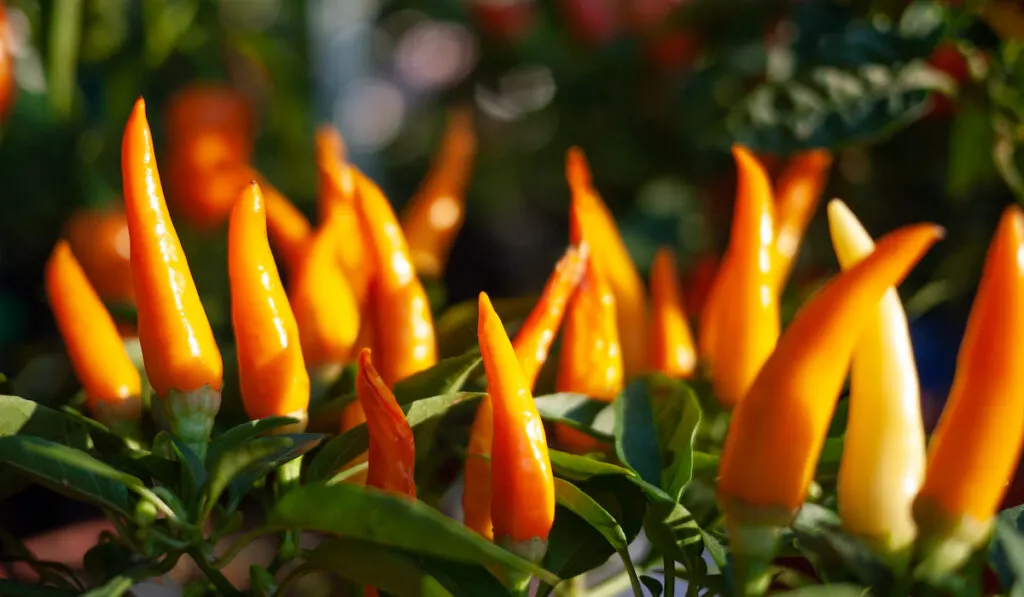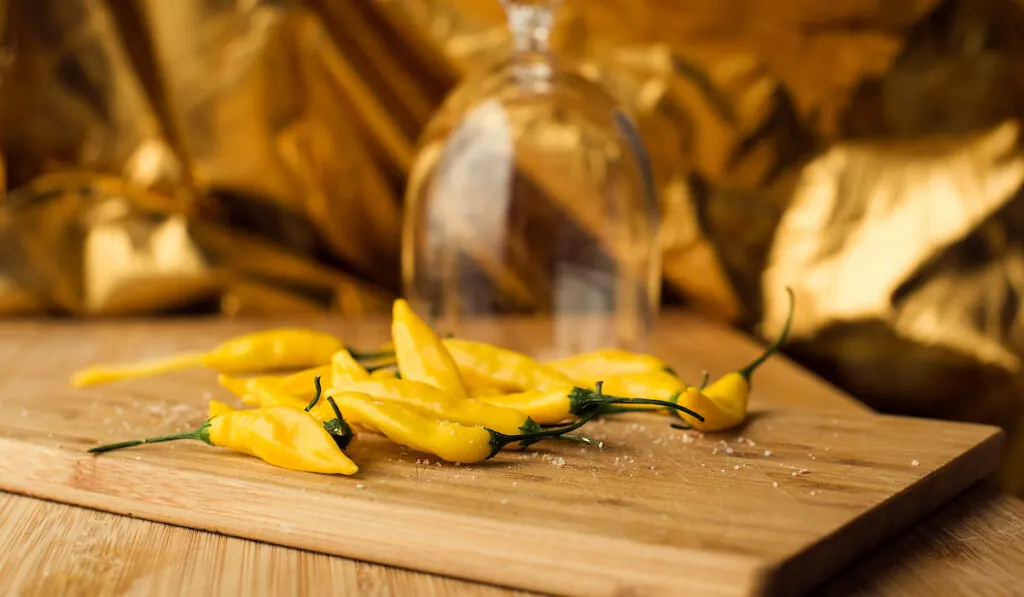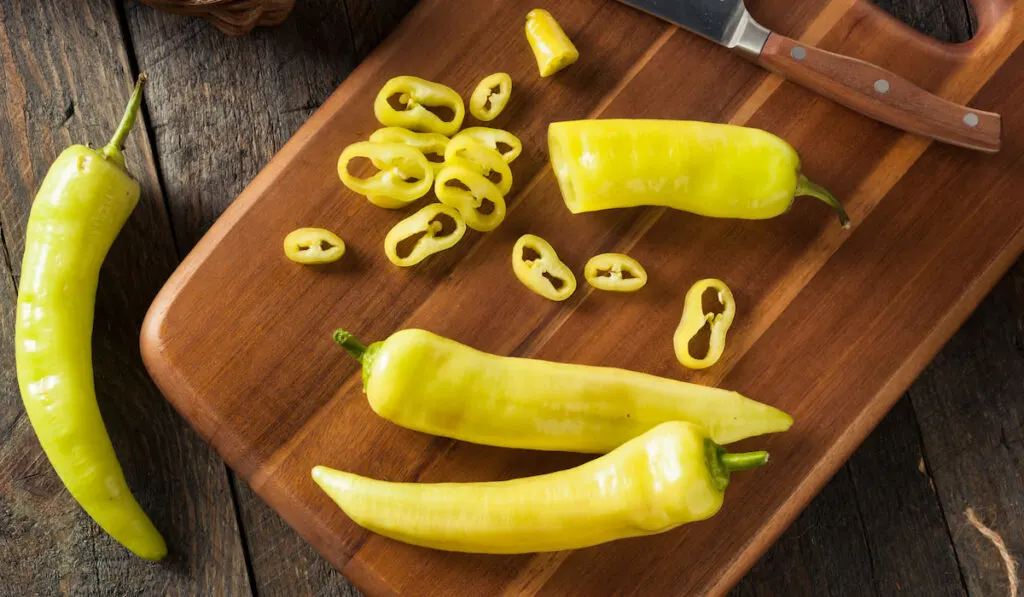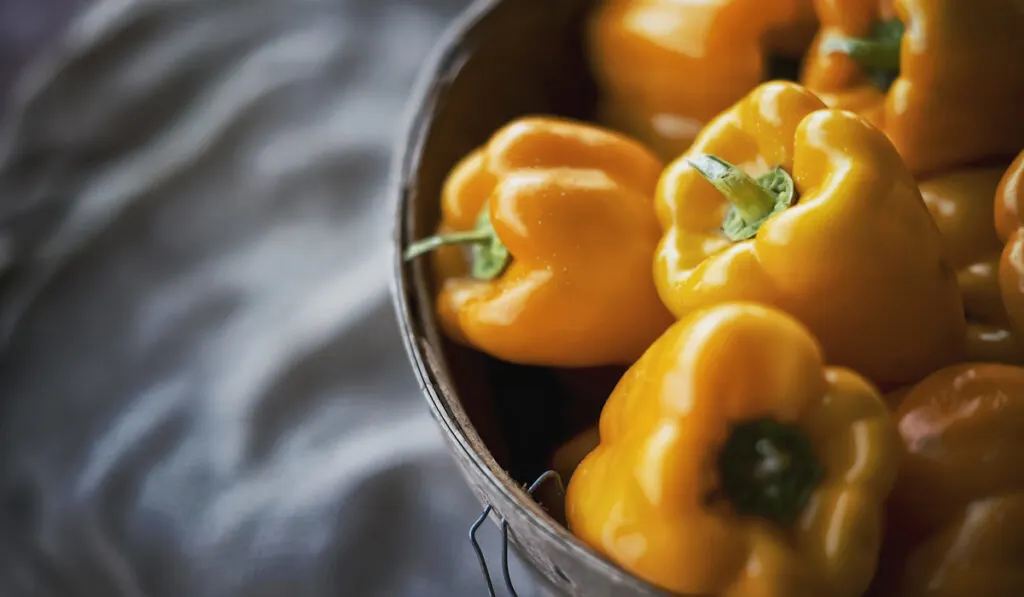Peppers come in a huge range of colors, sizes, and flavors. They are probably the most versatile of vegetables and can be used in pretty much any kind of cuisine. People’s love of peppers can be for their extra spicy qualities or for their sweet and mild qualities. Thank goodness for the Portuguese pilgrims and Europeans who introduced them to North America.
Yellow peppers are unique because they can taste a certain way while they’re yellow, but if you wait until they turn orange or red, they can exhibit a totally different taste.
If you’re looking for a yellow pepper to fill your meal out, we have a list of 7 that should work for your needs. We’ve also provided you with the Scoville Heat Units (the measurement of hotness) for each pepper so you can choose the right one for you.
Table of Contents
1. ‘Fatalii’ Pepper

This is an extremely hot pepper that is good for salsas and sauces. It has a citrusy and even fruity taste, but you might miss that because you’re looking for a drink to cool down your mouth.
There are red ‘Fatalii’ peppers too, however, these are not as often seen. The reds are hotter and are not an heirloom variety like the yellows.
Scoville Heat Units: 125,000-400,000
2. ‘Madame Jeanette’ Pepper
We see greater variations of shape here than in any other chili. They some of the time appear as a somewhat prolonged ring pepper. And other times they are meager, bent, and marginally creased like a habanero.
Sometimes they even have a pumpkin-like shape – like a goat pepper or Scotch bonnet – and they even can be seen with a scorpion-like tail. These chilies come in two tones: yellow (likewise called Suriname Yellow) and red (Suriname Red).
Scovile Heat Units: 125,000-325,000
3. ‘Devil’s Tongue’ Pepper
They look very like another habanero relative – the ‘Fatalii’ pepper. Developing to about three inches long, the ‘Devil’s Tongue’ is yellow and wrinkly.
It tightens to a tip, giving its tongue-like appearance (when you stick your tongue out to a point). It folds and overlaps to give itself a mean-looking shape – fitting both for the hotness in the pepper and its distinct name.
Like the habanero or ‘Fatalii’, the ‘Devil’s Tongue’ is fruity. There’s a citrus undertone alongside a somewhat tart snap. They are scrumptious on the off-chance that you can deal with the outrageous hotness.
Scoville Heat Units: 125,000-325,000
4. ‘Aji Amarillo’ Pepper

In Spanish, Aji signifies “chili” and Amarillo signifies “yellow”, so Aji Amarillo is a “yellow chili”. The name “yellow chili” addresses the look. Yet, as the ‘Aji Amarillo’ ages, it abandons yellow to blazing orange, similar to the actual sun.
They have thin walls with thick, succulent dividers. Several flavors can be detected – a clean bright taste, traces of tropical freshness, and a somewhat raisiny finish.
Its flavor profile makes it more usable across many recipes and dishes.
Scoville Heat Units: 30,000-50,000
5. ‘Lemon Drop’ Pepper

Assuming you love both citrus tang and peppery flavor, the ‘Lemon Drop’ pepper is a chili that you should become acquainted with. While it’s difficult to come by, the ‘Lemon Drop,’ (otherwise called ají Limon), is becoming more in-demand, both for eating and as a fancy pepper because of its brilliant yellow mature color.
It has a distinct citrus taste similar to a lemon. Yet, contingent upon your taste buds, the ground and temperature the chilies were grown in, and their development, the flavors from one pepper to another will fluctuate.
Some of the time it’s fruity, other times, it tastes a smidgen more like new lemongrass. The fruitiness makes the ‘Lemon Drop’ a less-impactful substitute for habanero pepper or Scotch bonnet, both of which have comparable degrees of fruity suggestions, however, they are several times more potent than the most blazing ‘Lemon Drop.’
Scoville Heat Units: 15,000-30,000
6. Banana Pepper

It does not shock anyone how the banana pepper got its name. It’s distinct shape sharply resembles that of a banana. Your child might be a little disappointed if you give them this pepper instead of their favorite fruit treat, though.
These sweet and tart peppers are ideal for pickling and delectable in servings of mixed greens and sandwiches.
Banana peppers will look great in your garden and they keep growing until the first frost. Use your abundant crop to make things like chow-chow, pickled peppers, and mild salsa.
Scoville Heat Units: 0-500
7. Hungarian Wax Pepper
Hungarian wax peppers look a lot like banana peppers but don’t get them confused or you could be in for a spicy surprise. They are not exceedingly hot, but if you’re expecting a banana pepper tang, it may knock you for a loop.
This pepper is excellent added to salads and for cooking things like chiles Rellenos.
Scoville Heat Units: 5,000-10,000
8. Bell Pepper

We’ll end this list with a pepper that can be found in almost any cuisine you can think of. It’s prevalent in Chinese food, Indian curries, Mexican fajitas, Middle Eastern kabobs and countless other styles of food. This pepper is beautiful and adds substance and class to any meal.
If you can’t take heat and you want a beautiful pepper to add to your stir-fries and salads, the bell pepper is exactly what you need. This bell-shaped pepper comes in many colors including the classic “stop light” colors of red, yellow, and green.
It has a sweet flavor that starts as only slightly sweet with the green color and becomes sweeter as the color changes. It also has a very satisfying crunch that makes it a favorite for use with dips in the place of chips. These peppers are a crowd favorite whether the crowd is made up of adults or kids.
Scoville Heat Units: 0
Final Thoughts
Peppers are an amazing vegetable. Whether you like things hotter than hot or you want a tangy sweetness to your meal, there is a pepper that can fulfill that need. Peppers are great raw, cooked, pickled, or any other way you can think to prepare them.
Peppers are also fun and easy to cultivate and grow in your own garden. To maximize your harvest, buy starts to plant in your garden and be sure to fertilize and water them. They are generally very easy to maintain and, as long as you keep them watered and weeded, you’ll keep getting peppers until the first frost.
Choose your favorite and plant it in your garden so you have an unending supply to add color and flavor to your meals!

Barbara
Wednesday 16th of March 2022
Thank you!! I've been growing these little yellow peppers for a couple of years not knowing what they are! I give them away a lot because I have so many and no one else knows the name---now I do! Lemon Drop. They're so good in. everything with the perfect amount of heat and the little citrus tang is a great addition to most anything.